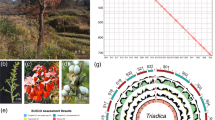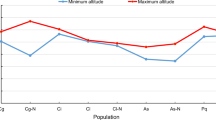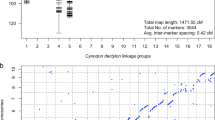Abstract
IN his recent article on “Plant Chromosome-Races and their Ecology in Great Britain”1, Dr. G. Haskell devotes a paragraph each to lady's smock (Cardamine pratensis) and to watercress (Nasturtium officinale agg.). So far as Cardamine pratensis is concerned, he omits to mention the work of Hussein2,3, who has made by far the largest study of the distribution of the two chromosome-races of this plant in Great Britain. Haskell states that in Great Britain, as in Sweden, the form with the lower chromosome number (2n = 30) is characteristic of drier conditions than the form with the higher chromosome number (2n = 56). This was found by Hussein, who says : “The ecological difference found by Lövkvist holds good in most of the cases recorded ; for example, Prof. R. D'O. Good, who kindly provided material from Dorset, noted particularly that the large plant, now found to have the low chromosome number, occurred in quantity on the damp roadside banks characteristic of Marshwood Vale, whereas the smaller darker-leaved one (2n= 56) grew in wet meadows”. It should also be noted that the chromosome number of Cardamine pratensis from Merton was found by Lawrence4 to be 2n = 30 (thus agreeing with counts made by Lövkvist5 and Hussein2,3 and with unpublished counts by myself for the lower chromosome number form) and not 2n = 32 as stated by Haskell, although Lawrence did suggest that it may have arisen from 2n = 32 by chromosome fusion.
This is a preview of subscription content, access via your institution
Access options
Subscribe to this journal
Receive 51 print issues and online access
$199.00 per year
only $3.90 per issue
Buy this article
- Purchase on Springer Link
- Instant access to full article PDF
Prices may be subject to local taxes which are calculated during checkout
Similar content being viewed by others
References
Haskell, G., Nature, 167, 628 (1951).
Hussein, F., Nature, 161, 1015 (1948).
Hussein, F., Rep. Bot. Soc. Brit. Isl. Conference of 1948, p. 77.
Lawrence, W. J. C., Genetica, 13, 183 (1931).
Lövkvist, B., Hereditas, 33, 421 (1947).
Manton, I., Z. Indukt. Abstamm. Vererb., 69, 132 (1935).
Howard, H. W., and Manton, I., Nature, 146, 303 (1940).
Howard, H. W., and Manton, I., Ann. Bot., N.S., 10, 1 (1946).
Airy Shaw, H. K., Kew Bull., No. 1, 39 (1947).
Howard, H. W., J. Min. Agric., 53, 453 (1947).
Howard, H. W., and Lyon, A. G., Watsonia, 1, 228 (1950).
Airy Shaw, H. K., Rep. Bot. Soc. Brit. Isl. Conference of 1948, p. 75.
Author information
Authors and Affiliations
Rights and permissions
About this article
Cite this article
HOWARD, H. The So-called Chromosome-Races of Cardamine pratensis and Nasturtium officnale. Nature 168, 477–478 (1951). https://doi.org/10.1038/168477b0
Issue Date:
DOI: https://doi.org/10.1038/168477b0
Comments
By submitting a comment you agree to abide by our Terms and Community Guidelines. If you find something abusive or that does not comply with our terms or guidelines please flag it as inappropriate.



